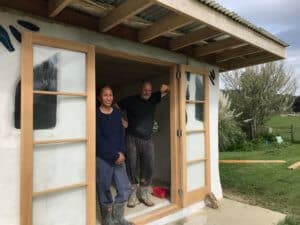A sustainable land-based practices programme is looking beyond education into truly sustainable living options for whānau.
Alice Kaiwai and EIT tutor Grant Steven with the earth house trial build they have been working on as part of the Ruatoria Learning Centre’s sustainability courses.
EIT’s Ruatoria Regional Learning Centre’s series of light earth building courses is creating a pathway for local whānau to explore alternative house construction methods utilising local and natural resources.
Alice Kaiwai studied the New Zealand Certificate in Primary Industry Skills Level 2 and then the New Zealand Certificate in Land Based Sustainable Practices Level 3 programmes.
A passionate advocate for the project, the EIT learning facilitator is now supporting other community members to develop skills in local sustainable practices.
A likely outcome is the creation of a local industry based around the concept of whānau gaining skills to provide healthy, affordable and accessible housing solutions.
“Home ownership is out of reach for many of our whānau,” says Alice. “The earth building courses have given us hope that we can build affordable accommodation for ourselves by utilising plentiful natural resources from the coast.”
A trial earth house is being constructed with framing material sourced from trees around Ruatoria. Other local materials being used include bamboo, pampas grass, raupo, manuka brush, wood shavings, river sand and clay.
The materials are all sourced from the East Coast and local Māori freehold land.
The walls are finished with a “stunning” white lime wash to aid in waterproofing, while the windows are re-purposed from local homes.
The prototype will be used to perfect techniques that work for the local environment. Leading architects from around New Zealand are providing support to develop construction methodologies and building science.
“We are so fortunate to have EIT facilitating this course,” says Alice.
“It has given our local people aims and goals. We come from a low socio-economic area. The earth buildings are affordable and sustainable for our whānau hapῡ.”
A tutor at the EIT’s Ruatoria Regional Learning Centre, Panapa Ehau oversees the sustainability courses. He says part of the industry development includes training students to teach earth building techniques to those in the wider region and elsewhere in New Zealand.
“It is about developing capacity in the community to use local natural resources for employment and accessible housing solutions. These courses are all about the health of the people, which increases educational and societal well-being.”
Research undertaken by Professor Philippa Howden-Chapman – a leading researcher in Māori health – shows that for every dollar spent on healthy housing there is significant payback to the community.
“For example, a child not having to stay home from school because they are ill means the parents don’t have to stay home from work – and there is not the cost of a doctor’s visit or medication,” says Panapa.
The benefits of community health initiatives are felt across the board in further regional learning centre courses such as the Mahinga Kai course focusing on home-grown organic food and new apiculture courses teaching people how to keep bees and sell honey to a booming global market.
“Basically if you can feed your people, house your people and provide jobs for your people, then you are going to have a massive increase in well-being.”
